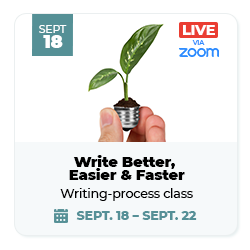Templates more effective than brainstorming, free association
Can creativity be templated?

Yes it can, according to a team of Israeli researchers.
The researchers studied 200 ads that had been award winners or finalists in top advertising competitions. The researchers found that nearly nine in 10 of the ads could be classified into six templates.
Next, they studied 200 less successful ads — those that had not earned awards. The researchers found that only 2.5% of those ads could be classified into templates.
‘All creative ads resemble each other …’
“The surprising lesson of this story: Highly creative ads are more predictable than uncreative ones,” write Chip and Dan Heath in Made to Stick.
“It’s like Tolstoy’s quote: ‘All happy families resemble each other, but each unhappy family is unhappy in its own way.’ All creative ads resemble one another, but each loser is uncreative in its own way.”
Traditionally, idea-generation techniques have focused on a lack of system and logic. We try to brainstorm as many different ideas as we can. We say, “there are no bad ideas.” We bring in diverse opinions through focus groups and free association.
But what if we’re wrong?
Find the patterns.
A better approach, according to the Israeli researchers, is to identify patterns in successful communications and brainstorm ways to implement those patterns.
This approach itself follows a pattern in creative thinking.
The researchers found that nearly nine in 10 of the ads could be classified into six templates.
Next time you’re developing a creative campaign, use these proven templates to jump-start your ideas:
- Pictoral analogy. This approach merges or replaces your central image with another one. An ad for the French Open Tennis Championship, for instance, featured a tennis ball shaped like a croissant.
- Consequences. For this approach, point out unexpected consequences of a product attribute. A commercial for car loudspeakers, for instance, showed a bridge on the verge of collapse when the speakers of a car parked on it were turned way up.
- Extreme situation. This approach shows a product performing under unusual circumstances or exaggerates a product’s features to the point of absurdity. A commercial for locks, for instance, shows a woman barking at burglars to scare them away.
- Competition. For this approach, show your product or service winning in competition with something else. One ad, for instance, shows a person trying to decide whether to answer a ringing phone or finish eating the advertised cereal.
- Dimensionality alteration. A woman is arguing with her husband for canceling his life insurance. In a moment, it becomes clear that the scene occurs after he has died, during a séance.
- Interactive experiment. For this template, you invite the viewer to perform or to imagine performing an experiment that demonstrates a need or problem that your product or service can solve.
Why reinvent the wheel?
Call it thinking inside the box: The irony is that frameworks, formulas and templates like these can actually help you come up with more effective creative ideas than “free-thinking” techniques.
What templates could you use to make your messages more creative?
____
Sources: Jacob Goldenberg, David Mazursky, and Sorin Solomon, “The Fundamental Templates of Quality Ads,” Marketing Science 18 (1999), 333-51
Chip Heath and Dan Heath, Made to Stick: Why Some Ideas Survive and Others Die, Random House, 2007
Work with — not against — your brain
While we talk a lot about what to write — More stories! Fewer words! Shorter sentences! — we don’t focus so much on how.

Writing is hard because we weren’t taught how to write. Instead, we were taught how to edit: how to spell, punctuate and use the right grammar.
But there is a how to writing. Learn a few simple steps that will make your writing time more effective and efficient at How to write Better, Easier & Faster — our writing-process workshop starting Sept. 18.
You’ll learn to invest your time where it’ll do you the most good … stop committing creative incest … even save time by editing before writing.
Save up to $100 with our group discounts.
